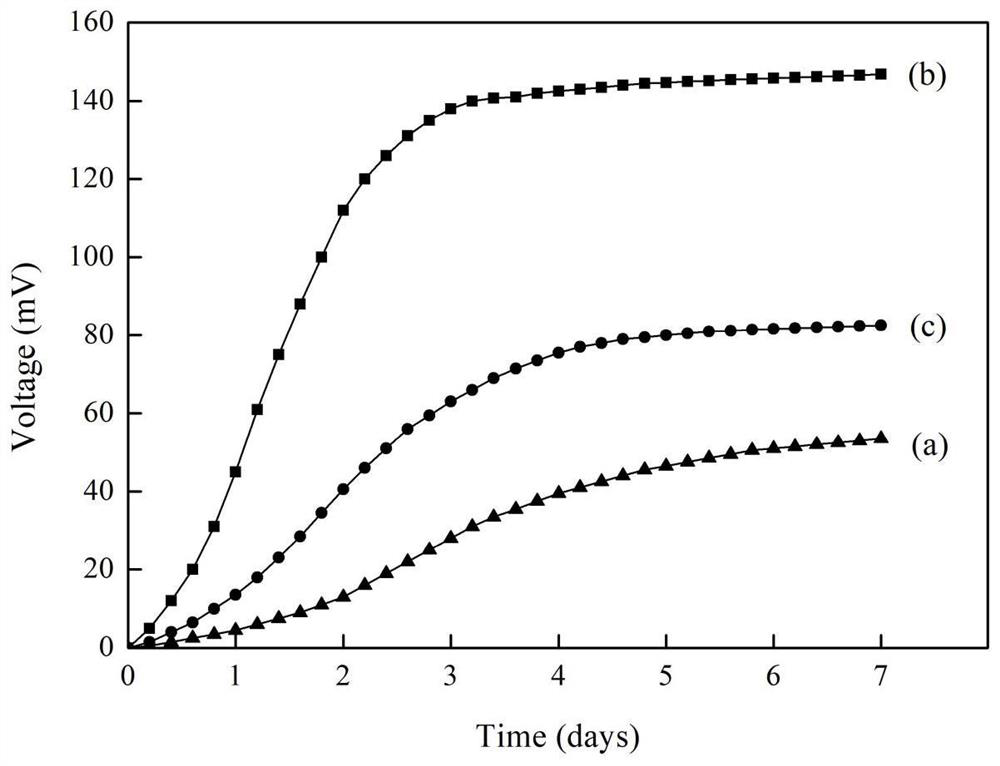Microbial electrode and preparation method thereof
A technology of microbial electrodes and electroactive microorganisms, applied in battery electrodes, biochemical fuel cells, circuits, etc., can solve problems such as unoptimized electricity production performance, and achieve excellent electron transfer properties, high electroactivity, and improved electricity production performance Effect
- Summary
- Abstract
- Description
- Claims
- Application Information
AI Technical Summary
Problems solved by technology
Method used
Image
Examples
Embodiment 1
[0046] Using carbon felt as the electrode base material, it was cut into a 3cm diameter disc, soaked in acetone solution overnight, fully washed with deionized water, and dried; after drying, the carbon felt was soaked in a concentrated nitric acid solution with a concentration of 60% by mass , boiled for 0.5h in a nitric acid reflux device, and washed alternately with deionized water and ethanol; put the acidified carbon felt into 0.005g / mL 1-ethyl-3-(3-dimethylaminopropyl)carbon two In imine (EDC) and 0.005g / mL N-hydroxysuccinimide (NHS) solution, stir at room temperature for 0.5h, the soaking ratio is 20-30mL solution per gram of substrate; add a certain amount of 3-aminophenylboronic acid to make The concentration was 0.01g / mL. After continuing the reaction for 10h, fully washed with ultrapure water and then vacuum dried at 20 °C for 10h; the carbon felt with phenylboronic acid immobilized on the surface was soaked in 2g / L glucose solution for 1h, and the ultrapure water wa...
Embodiment 2
[0048] The carbon brush was used as the electrode base material, soaked in acetone solution overnight, fully washed with deionized water, and dried; after drying, the carbon brush was soaked in a concentrated nitric acid solution with a concentration of 70% by mass, and boiled in a nitric acid reflux device 6h, alternately wash with deionized water and ethanol; put the acidified carbon brush into 0.04g / mLEDC and 0.02g / mL NHS solution, stir at room temperature for 2h, add a certain amount of 3-aminophenylboronic acid to make the concentration 0.2g / mL mL, continued the reaction for 14 h, washed thoroughly with ultrapure water, and dried in vacuum at 30 °C for 14 h; the carbon brush with phenylboronic acid immobilized on the surface was soaked in 4 g / L glucose solution for 1 h, and washed with ultrapure water; the modified carbon brush The brush base material was co-cultured with the Shewanella oneidensis MR-1 suspension, rotated at 1000 rpm, and after 7 days of incubation, the el...
Embodiment 3
[0050] Carbon nanotubes were soaked in acetone solution overnight, fully washed with deionized water, collected by centrifugation and dried; the dried carbon nanotubes were soaked in concentrated nitric acid solution with a concentration of 65% by mass, and boiled in a nitric acid reflux device for 30min , after centrifugal collection, alternately wash and centrifuge with deionized water and ethanol; put the acidified carbon nanotubes into 0.02g / mLEDC and 0.01g / mL NHS solutions, stir at room temperature for 1 h, and add a certain amount of 3-aminophenylboronic acid to make them The concentration was 0.1 g / mL, and the reaction was continued for 12 h, then centrifuged for collection, fully washed with ultrapure water, and then vacuum-dried at 25 °C for 12 h; the carbon nanotubes with phenylboronic acid immobilized on the surface were soaked in 8 g / L glucose solution for 1 h to obtain ultrapure Washed thoroughly with water; the modified carbon nanotubes were co-cultured with G.sul...
PUM
 Login to View More
Login to View More Abstract
Description
Claims
Application Information
 Login to View More
Login to View More - R&D
- Intellectual Property
- Life Sciences
- Materials
- Tech Scout
- Unparalleled Data Quality
- Higher Quality Content
- 60% Fewer Hallucinations
Browse by: Latest US Patents, China's latest patents, Technical Efficacy Thesaurus, Application Domain, Technology Topic, Popular Technical Reports.
© 2025 PatSnap. All rights reserved.Legal|Privacy policy|Modern Slavery Act Transparency Statement|Sitemap|About US| Contact US: help@patsnap.com

